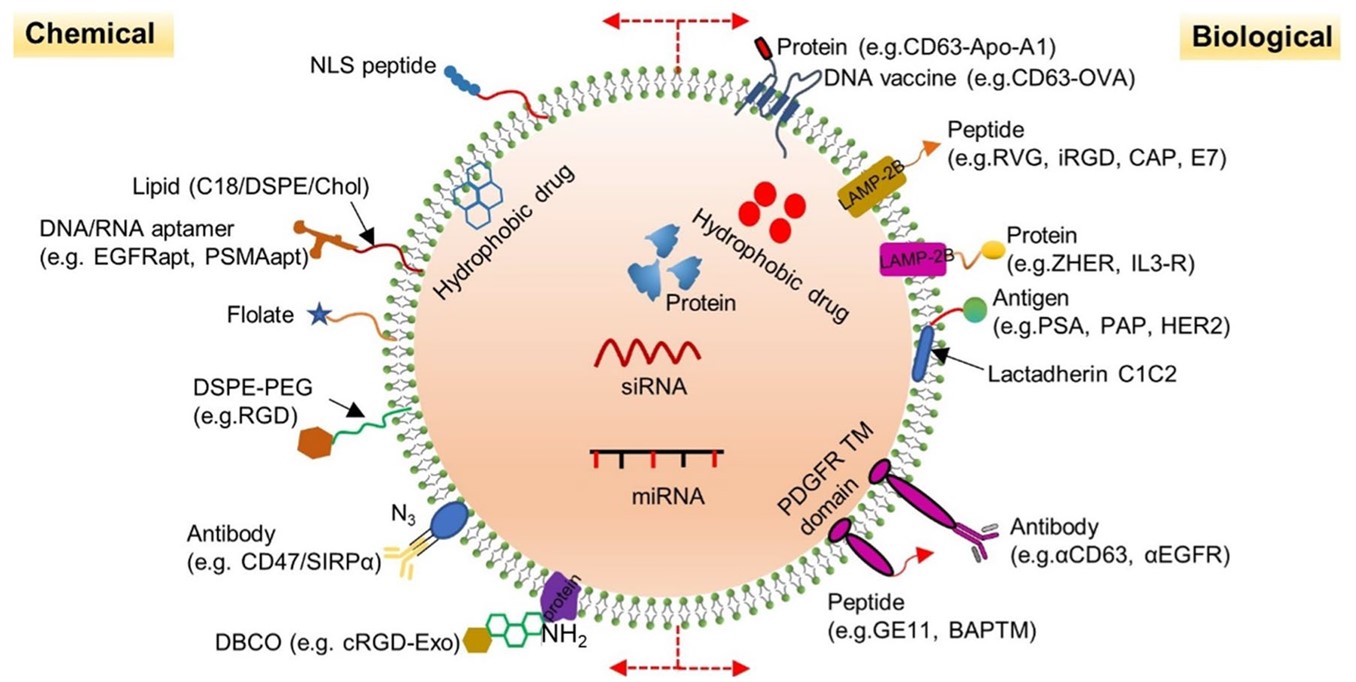Exosome Display-based Antibody Generation and Isolation (ExoMAb) Service
Overview Services Features FAQs
Creative Biolabs is using exosome display technology to promote the development of membrane protein therapies by generating and isolating antibodies against various pharmacological targets.
Exosome Display of Different Proteins
There are two ways that proteins can enter exosomes. The extracellular domains of receptors and soluble proteins are subject to the first transfer way. Generally, the C1C2 domain of lactadherin is used to address the proteins to the exosome surface. All transmembrane membrane proteins fall under the second mode. Due to the difficulties of obtaining purified soluble transmembrane proteins in their native conformation, exosomes have been used as a display platform to present and overexpress these proteins on exosomal surfaces. Exosome display of proteins offers many advantages, including:
-
Provide an environment that is conducive to the appropriate conformation, activity, and dispersion of membranes.
-
Offer many possibilities to tailor exosomes with desirable functions.
-
Represent a unique and cost-effective antigen presentation platform to enrich membrane proteins for antibody development.
ExoMAb Approach for Antibody Development against GPCRs
The application of Exosome Display to the generation of antibodies is called the ExoMAb approach. This approach applies to antibody induction and screening in situations where the antigen is either difficult to produce or poorly immunogenic. Besides, the induction of antibody responses upon immunization with antigen bound to exosomes may be achieved while maintaining the scale of immunogen preparation to a minimum due to the potent adjuvant activity of exosomes. Furthermore, antigen purification—which is carried out in conjunction with the purification of exosomes under non-denaturing conditions—is time-consuming and expensive when using ExoMAb technology. This process involves 2 key steps:
-
Recombinant exosomes bearing target antigens are generated, purified, and characterized, followed by immunization of animals (e.g., mice) to induce antibody responses.
-
Labeled recombinant exosomes are used to screen and/or sort antibody repertoires to identify and isolate antibody-producing cells. Antibody repertories can be primary cells, hybridoma from immunized mice, or libraries of recombinant antibodies.
 Fig. 1 The chemical and biological modification on exosome surfaces.1
Fig. 1 The chemical and biological modification on exosome surfaces.1
Features
-
Custom-specific project designs that allow antibody development against different antigens, especially GPCRs
-
Professional scientists and employees collaborate closely with clients to deliver gratifying customer care support
-
Streamlined services ranging from project design and consultancy to product manufacturing and data analysis
-
Guaranteed superior quality, reliable repeatability, and prompt delivery
-
Suitable for various downstream applications and research objectives
Scientists in Creative Biolabs have been working on exosome research for many years, especially specializing in exosome display for antibody production. We are confident in offering the best exosome antibody development services based on exosome display techniques. Please contact us and start the conversation.
FAQs
Q: How does the ExoMAb technology work?
A: Exosomes are engineered to express particular antigens on their surface for ExoMAb technology to function. Afterward, animals can be immunized against these exosome-displayed antigens, or they can be directly screened for antibody production. High-affinity antibodies with improved specificity and functionality can be isolated using this procedure.
Q: What applications can benefit from ExoMAb-generated antibodies?
A: Antibodies generated using ExoMAb can be applied in various fields, including:
-
Biomedical Research: For studying protein interactions and pathways.
-
Diagnostic Development: To create highly specific diagnostic tests for diseases.
-
Therapeutic Development: In developing treatments for diseases like cancer and autoimmune disorders.
-
Biotechnology: For creating research tools and reagents.
Q: How can ExoMAb improve the antibody discovery process?
A: ExoMAb offers a more effective and focused method for producing antibodies, which enhances the antibody discovery process. The technology allows for the rapid screening of large libraries of antibodies and facilitates the selection of those with the highest affinity and specificity for the target antigen, reducing the time and cost associated with antibody discovery.
Reference
-
Zhang, Ying, et al. "Recent advances in exosome-mediated nucleic acid delivery for cancer therapy." Journal of nanobiotechnology 20.1 (2022): 279. Under Open Access license CC BY 4.0, without modification.
For Research Use Only. Cannot be used by patients.
Related Services:

 Fig. 1 The chemical and biological modification on exosome surfaces.1
Fig. 1 The chemical and biological modification on exosome surfaces.1









